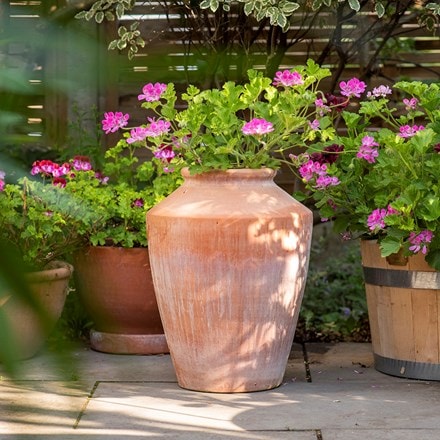Geranium maderense
giant herb robert
- 9cm pot
- £12.99
- available to order from spring
- 3 × 9cm pots
- £29.99 £10.00 each
- available to order from spring
Delivery options
- Standard £5.99
- Position: full sun, partial shade or shade
- Soil: fertile, well-drained soil
- Rate of growth: average
- Flowering period: June to August
- Hardiness: borderline hardy (may need winter protection)
Erupting like a living fountain, this architectural marvel bursts forth with hundreds of reddish-mauve blooms hovering above a spectacular rosette of glossy, dissected foliage.
Geranium madarense, the true Madeiran cranesbill, commands attention with its bold structure, rising dramatically to 1.5m on stout, succulent stems crowned with leaves spanning 20cm (8in) across. This show-stopping short-lived perennial builds suspense over two to three years before unleashing its grand finale – a dazzling display of 4cm (2in) wide flowers, each intricately veined in darker tones, creating a magenta-pink explosion visible from across the garden.
Though not fully hardy below -4°C and monocarpic (dying after its theatrical flowering), this extraordinary plant happily self-seeds in sheltered, sunny positions, ensuring future generations of this spectacular Mediterranean native continue to captivate.
Geranium madarense, the true Madeiran cranesbill, commands attention with its bold structure, rising dramatically to 1.5m on stout, succulent stems crowned with leaves spanning 20cm (8in) across. This show-stopping short-lived perennial builds suspense over two to three years before unleashing its grand finale – a dazzling display of 4cm (2in) wide flowers, each intricately veined in darker tones, creating a magenta-pink explosion visible from across the garden.
Though not fully hardy below -4°C and monocarpic (dying after its theatrical flowering), this extraordinary plant happily self-seeds in sheltered, sunny positions, ensuring future generations of this spectacular Mediterranean native continue to captivate.
Incorporate plenty of organic matter when planting and water well in dry weather, especially newly established plants. Apply a generous 5-7cm (2-3in) mulch of well-rotted manure or garden compost around the plant to help seal in moisture, feed the soil, and reduce the need for weeding.
Deadhead spent flowers regularly to encourage continuous blooming. If the plant becomes too leggy or untidy later in the season, trim lightly to encourage fresh growth and more flowers.
During the first growing season, regular watering is crucial to establish deep roots. Once established, Geraniums show improved drought tolerance. A feeding of balanced, slow-release fertiliser in spring will support blooming.
At the end of the growing season, cut it back to ground level in late autumn or early spring. Every 3-4 years, consider dividing the plant in spring to maintain its vigour.
Deadhead spent flowers regularly to encourage continuous blooming. If the plant becomes too leggy or untidy later in the season, trim lightly to encourage fresh growth and more flowers.
During the first growing season, regular watering is crucial to establish deep roots. Once established, Geraniums show improved drought tolerance. A feeding of balanced, slow-release fertiliser in spring will support blooming.
At the end of the growing season, cut it back to ground level in late autumn or early spring. Every 3-4 years, consider dividing the plant in spring to maintain its vigour.




